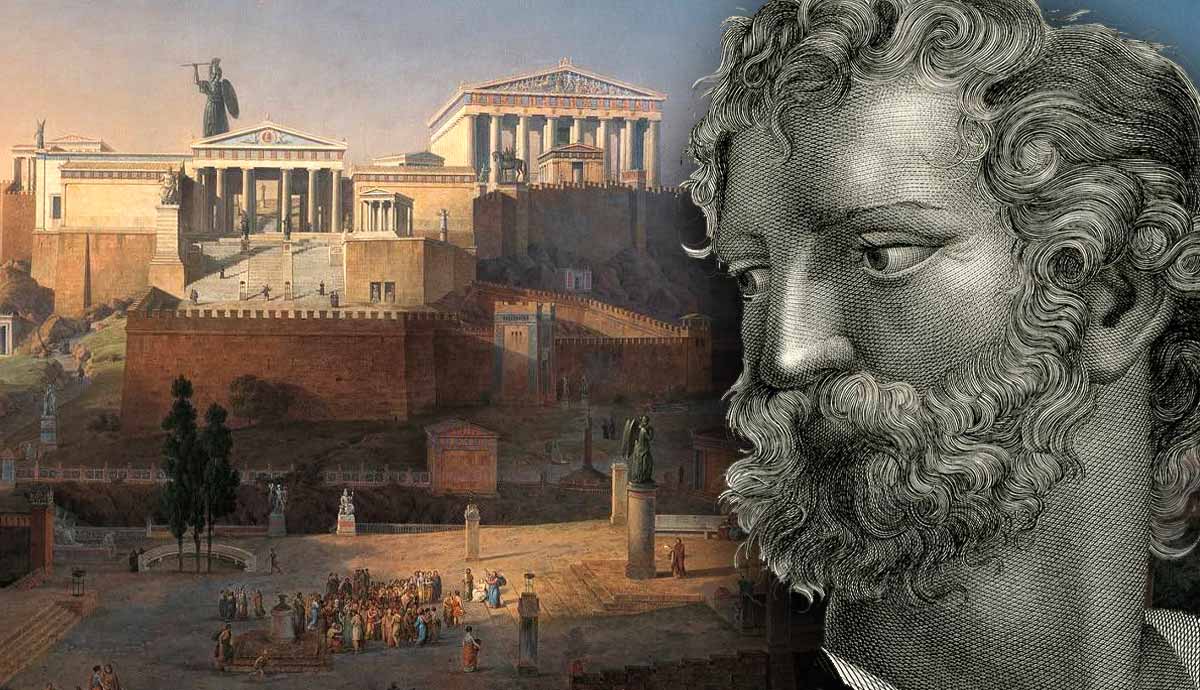
Aristotle took a stance on almost every possible philosophical debate of his time, but more importantly, he came up with new issues and kickstarted new discussions as well. Aristotle was one of the first thinkers to delve into rhetoric and contributed greatly to its forming and development. He came up with many insights and theories on the topic of linguistics within rhetoric. However, his communication model remains his most prominent theory to this day. Let’s see what his model of communication consists of.
Introduction to Aristotle’s Model of Communication

Before we begin analyzing Aristotle’s model of communication, some context is needed. Aristotle was one of the first philosophers that worked on the art of speaking. It was his treatise Rhetoric that founded the basic principles of rhetorical theory and spoke openly about the art of persuasion. To this day, most rhetoricians regard it as the most important single work on persuasion ever written. That’s why Aristotle’s model of communication is still used to this day.
Aristotle’s model of communication is also known as the “rhetorical triangle” or as the “speaker-audience-message” model. It consists of three main elements: the speaker, the audience, and the message.
1. The Speaker
The speaker is the person who is delivering the message. In this model, the speaker is responsible for creating and delivering the message effectively. This includes not only the words used but also the delivery style, tone, and body language.
2. The Audience
The audience is the group of people who receive the message. In this model, the audience is considered an essential part of the communication process. The speaker needs to understand the audience’s needs, interests, beliefs, and values to effectively communicate the message.
3. The Message
The message is the content of what is being communicated. In this model, the message should be clear, concise, and persuasive. The message should be crafted with the audience in mind to ensure that it is relevant and engaging.
Aristotle’s model of communication is important because it seems plausible and valid even in our modern lives. His model consists of three bullet points or three main important elements. That’s why we’ll explore each of them one by one.
The First Element of Communication: Ethos

The first element Aristotle comes up with is what he calls ethos. Ethos is essentially the speaker’s credibility to talk about the subject that he’s talking about and discuss it openly and with certainty.
What Aristotle means by ethos is the process of the speaker establishing his credibility about the subject he’s talking about. That can simply be done by mentioning the area of expertise he had majored in, but it can also be done by demonstrating his ability to back up his arguments. Credibility can also be built by using evidence, citing sources, or drawing on the speaker’s own experience or expertise. That’s why having empirical data to back up your arguments with clear proof is essential for this point.
What this does to an audience is create an image of the speaker as someone who knows what they are talking about and as someone that they can easily rely on and trust. That’s why Aristotle mentions it as the first important point out of the 3 most important ones.
The Second Element of Communication: Pathos

The second most important element of communication is what Aristotle calls pathos. The literal translation of pathos is emotion. Pathos is essentially the speaker establishing an emotional connection with the audience he’s speaking to.
The idea behind pathos is that the audience has to feel that they are being communicated with or that they are, in a way, interconnected. Emotional bonds will make the listeners fascinated, and they feel the speaker is “one of them.” In certain situations, the audience might want to feel more confident; in others, sadder, angry, or emotional. So, in Aristotle’s model of communication, pathos refers to the emotional appeal of a message. It focuses on engaging the audience’s emotions and creating a connection with them in order to persuade or influence their attitudes, beliefs, or behaviors.
Pathos can be conveyed through various elements of communication, such as tone of voice, facial expressions, body language, and the use of vivid language and imagery. In order to effectively use pathos in communication, Aristotle suggested that speakers should have a deep understanding of their audience and their emotional state. By appealing to their emotions and creating a connection with them, speakers can make their message more memorable and impactful.
The Third Element of Communication: Logos

The third most important element of communication Aristotle points out is logos. Logos refers to the logical or rational appeal of a message. This element focuses on the substance of the message and how it is presented to the audience.
Logos can be seen as the argument or reasoning behind a message, and it is often used to appeal to the audience’s sense of logic or reason. While ethos refers to the credibility or trustworthiness of the speaker or source of the message, and pathos refers to the emotional appeal in a message, logos focuses on the logical appeal and the argumentative structure of the message itself.
In order to effectively use logos in communication, Aristotle suggested that speakers should use clear and logical arguments, present evidence or facts to support their claims, and use reasoning to connect their ideas and persuade their audience. By appealing to the audience’s sense of logic and reason, speakers can create a persuasive message that is grounded in substance and can effectively influence their audience.
Criticisms of Aristotle’s Model of Communication

Now that we’ve carefully analyzed Aristotle’s model of communication, it’s time to look into the strong and weak points of the theory.
When it comes to the theory’s strengths, we can mention the following. First and foremost, the model emphasizes the importance of understanding the audience and adapting the message to their needs and interests. This means that the model’s main focus is figuring out the best approach to get through to the audience and their concerns, needs, and interests.
The second advantage this model provides is a clear structure for organizing a persuasive message, including the use of logos, ethos, and pathos. This makes it easier for the speaker to tailor his speech easily by following a particular structure. The third strength of this model is that it shows the importance of effective delivery techniques, such as tone and body language, which can enhance the impact of the message. Through these techniques, the speaker can easily point out a particular sentence or saying that he wants the audience to notice, for example.

However, regardless of the model’s many strengths, many of them unmentioned here, it is important to think critically and mention some of its weaker points and limitations.
First, the model is primarily focused on persuasion and may not be as useful in non-persuasive communication contexts. The model’s main use is having an audience involved at an event of a certain kind, which is why it may not be efficient for everyday use.
The second and probably most notable limitation of this theory is that the model assumes that communication is a linear process and does not account for the dynamic and interactive nature of communication. This means that the model does not leave any space for any sort of feedback, questions, or brainstorming sessions from the audience, taking them to be passive listeners to the speech the speaker is giving. Thus, the model is only applicable to public speaking of a very specific kind.
Some thinkers object to this limitation. Even though Aristotle’s model of communication is mostly associated with public speaking and formal communication situations, they say, the principles of effective communication outlined in Aristotle’s model can also be applied to everyday communication. For example, understanding the audience’s needs and interests can help us communicate more effectively with friends, family members, and coworkers. Crafting a clear and concise message can also help us avoid misunderstandings and conflicts in everyday interactions. Aristotle’s model of communication emphasizes the importance of understanding the audience and crafting a persuasive message, which is an essential skill in all types of communication, whether it’s public speaking or everyday conversation. Still, the model’s limitation still stands and is plausible.
The third limitation is that the model may not account for contextual factors that can influence communication, such as cultural differences or power dynamics.
The Lasting Influence of Aristotle’s Model of Communication

In conclusion, Aristotle’s model of communication is a timeless framework that still has relevance today. The three elements of ethos, logos, and pathos provide a solid guide for speakers to effectively communicate their message and persuade their audience. Ethos focuses on the credibility and trustworthiness of the speaker, logos emphasizes the use of logic and reasoning in the message, and pathos is the emotional appeal that creates a connection with the audience.
While Aristotle’s model of communication is widely recognized as a classic, other similar models have emerged in the field of communication. For instance, Berlo’s model of communication incorporates four elements, including source, message, channel, and receiver, and emphasizes the importance of feedback in the communication process (thus avoiding one of the weaknesses of Aristotle’s approach). Similarly, Shannon and Weaver’s model of communication focuses on the transmission of a message through a channel and highlights the role of noise and distortion in the communication process.
It’s also important to mention that Aristotle was not the first one to notice the power that language can have. The Sophists taught a lot about language, and even Aristotle’s mentor Plato talked extensively about language as well. However, it was Aristotle that contributed the most to the forming of rhetoric as a discipline. Aristotle’s model of communication remains an important foundation for understanding effective communication, and it continues to influence contemporary models and theories in the field of communication.










